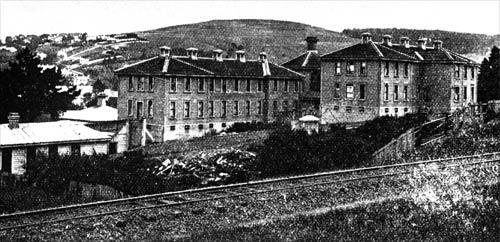
Dunedin’s first immigration barracks was a 20-metre-long whare (hut) consisting of flax-bound posts, raupō and grass walls, and a thatched roof. Inside, single women were located at the far end, married couples in the middle, and single men by the door. There were no partitions and cooking was done outdoors.
In the early 1870s new barracks, shown here, opened in the suburb of Caversham. They were able to accommodate 400 people – by now families, single men and single women were physically separated. Each group had their own ablution and dining areas, and mixing between groups was forbidden to prevent sexual relationships. The married quarters had separate sleeping rooms, but the single quarters comprised dormitories and bunk beds. Near the entrance were suitably furnished ‘engaging offices’, where employers could interview prospective employees.
The building fell into disuse in 1888 after immigration schemes went into abeyance. It was used as a match factory before being demolished in the early 1900s.
Te whakamahi i tēnei tūemi
Hocken Library, University of Otago
Reference:
S11-148c
Permission of the Hocken Library Uare Taoka o Hakena, University of Otago, must be obtained before any re-use of this image. Further information may be obtained from the Library through its website.









Tāpiritia te tākupu hou